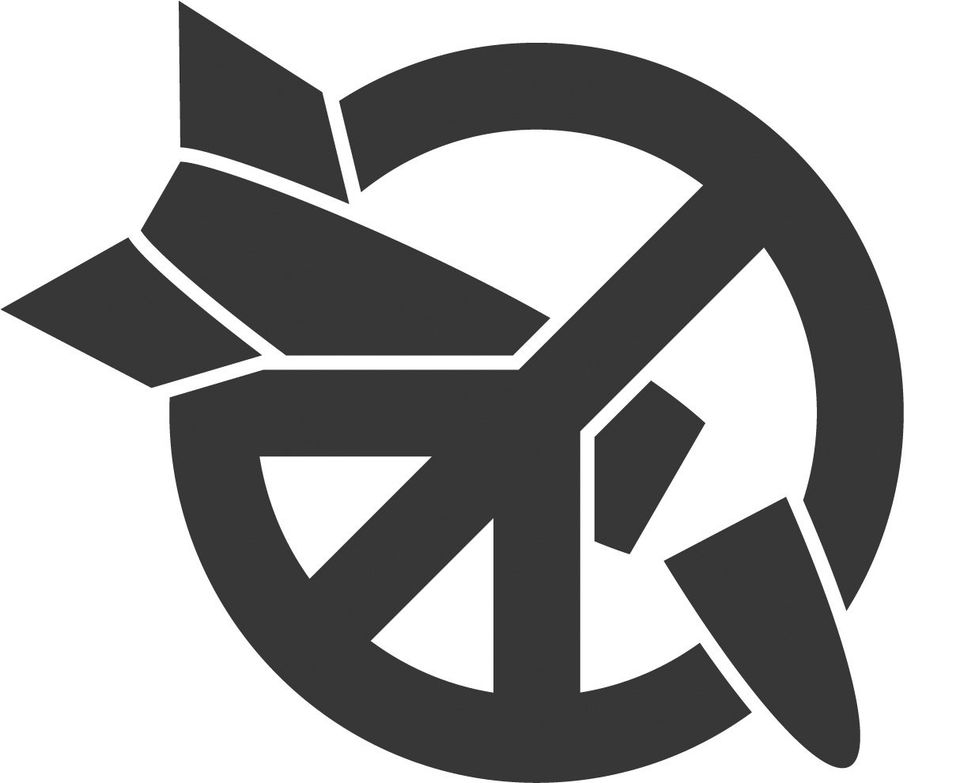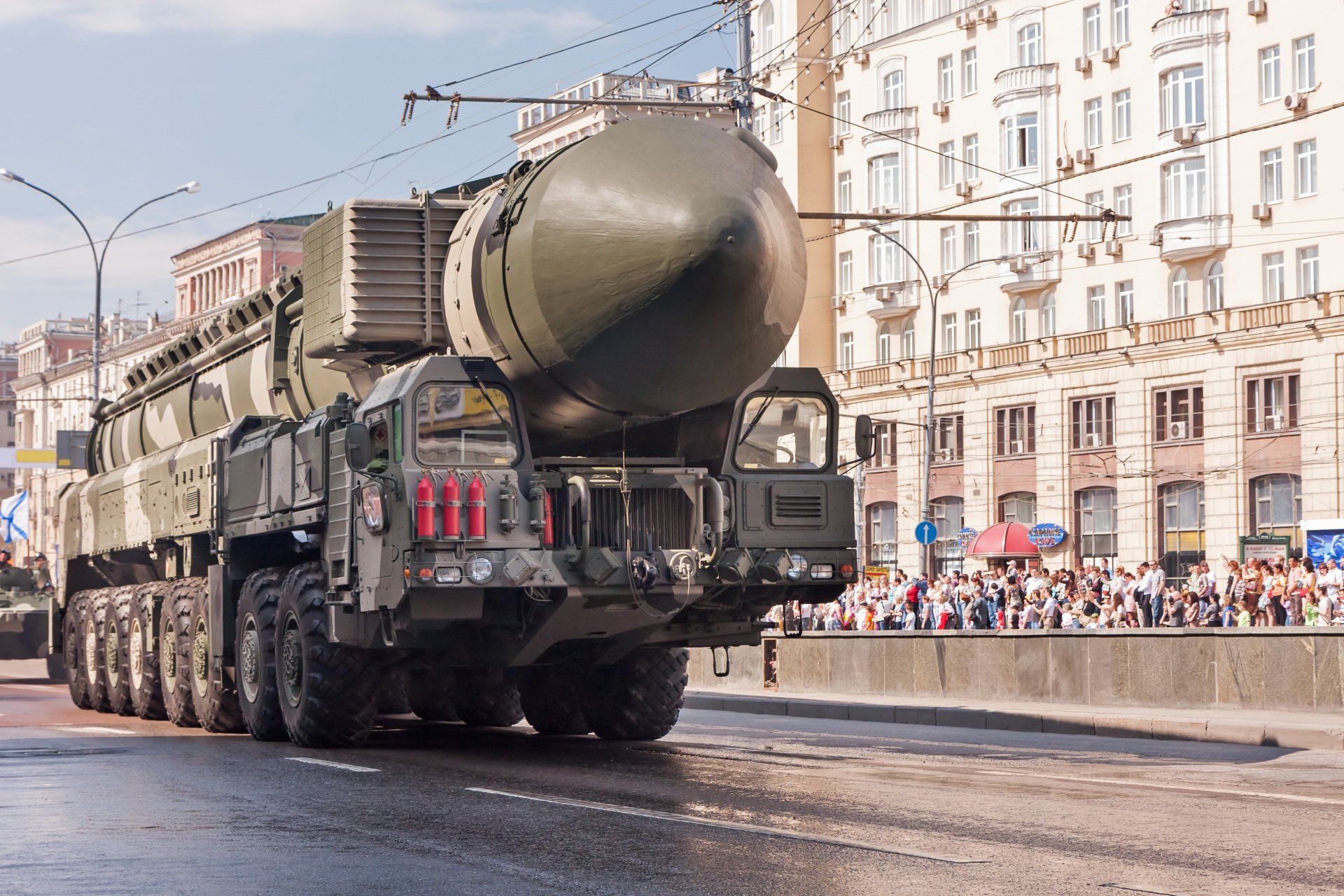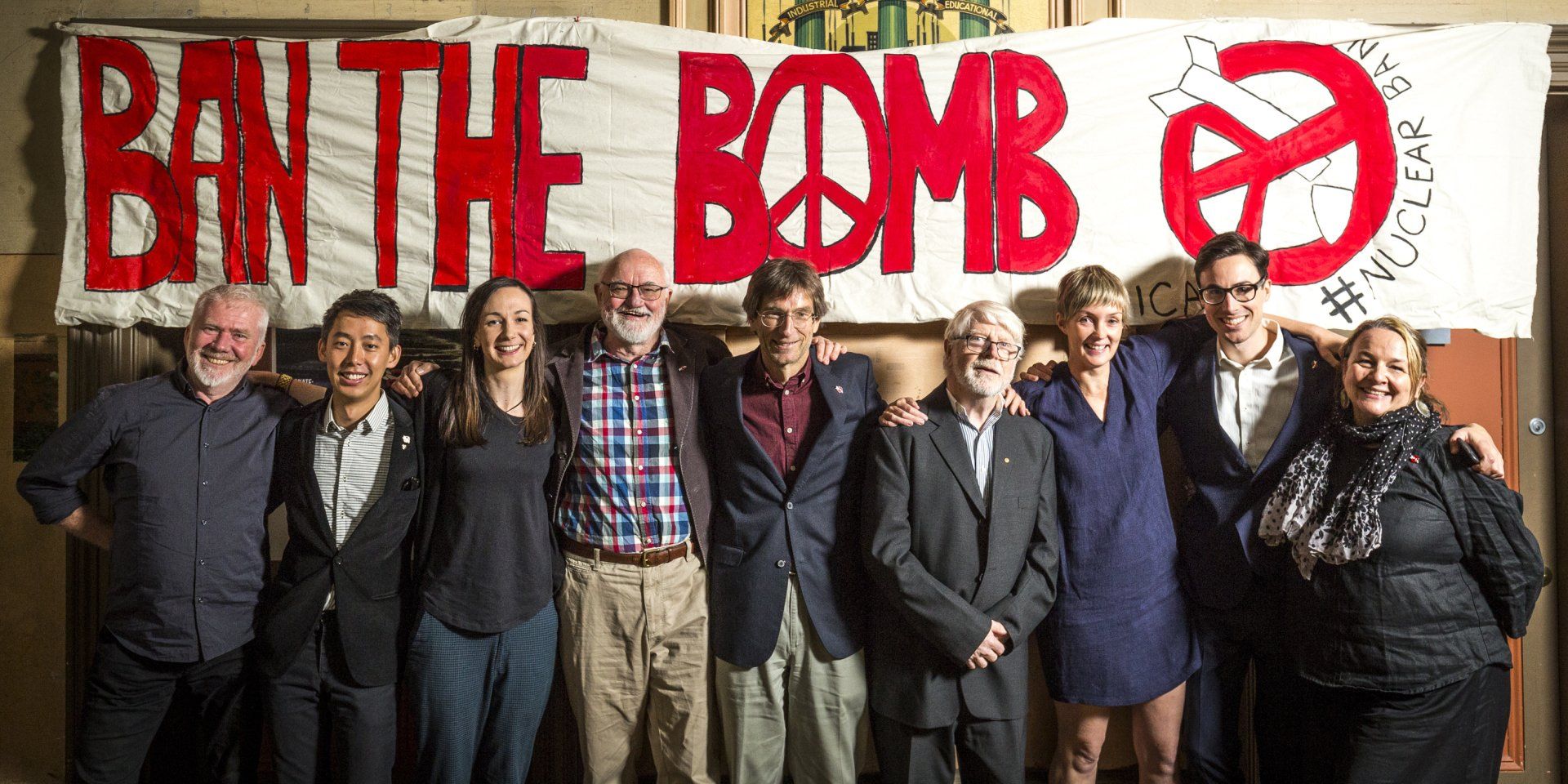Banning the Bomb
Banning the Bomb
ICAN - International Campaign to Abolish Nuclear Weapons
Nobel Peace Prize 2017
A group of peace activists, scientists, doctors, and environmentalists from Melbourne formed ICAN, the International Campaign to Abolish Nuclear Weapons, in 2007, and in 10 years broke through the barriers of half a century of failure. Their efforts to create and negotiate a UN treaty prohibiting nuclear weapons saw them awarded the Nobel Peace Prize in 2017.
A group of peace activists, scientists, doctors, and environmentalists from Melbourne formed ICAN, the International Campaign to Abolish Nuclear Weapons, in 2007, and in 10 years broke through the barriers of half a century of failure. Their efforts to create and negotiate a UN treaty prohibiting nuclear weapons saw them awarded the Nobel Peace Prize in 2017.
Nuclear weapons are the most lethal, destructive force to ever be born from the pursuit of science. Forged in the fires of the most horrific conflict the world has ever seen, WWII, their power is indiscriminate and absolute.
The world has banned chemical weapons, landmines, and other vestiges of past wars that cause harm for generations, but is yet to establish a comprehensive framework for the phase out of nuclear weapons.
Australia’s sole peace prize was won by the International Campaign to Abolish Nuclear Weapons, an effort born out of Melbourne, and a unique confluence of activists banding together: scientists, peace activists, environmentalists, and doctors.
Associate Professor Tilman Ruff OAM, David Sweeney, Dimity Hawkins AM, Dr Bill Williams, and Sue Wareham took up an idea proposed by Malaysian colleague Datuk Dr Ron McCoy.
Melbourne has a proud history of thinking in new ways about old issues – workers in the state led the way internationally on labourer’s rights, with the eight-hour day first achieved through the political activism and protest in 1856, years before most of the world caught up.
Bringing together scientific, moral, and intellectual approaches, alongside medical, political, and legal evidence, ICAN has been able to construct a progressive way forward around the intractability of nuclear disarmament. A focus on Humour, Hope, and Humanity drives the organisation’s work, aiming to convey the devastation the weapons can wreak, point out the absurdity in the prevailing orthodoxy, and inspire a belief that this was not the way the world had to be.
ICAN’s founding members recognised in the mid-2000s that the policies, ideas, and political functions around nuclear disarmament were bogged down, and pushed for a new way we could move forward.
This needed to combine innovative ideas around security, combined with humanitarian ideas about policy.
Most importantly, ICAN centred their advocacy around survivors of nuclear weapons, giving voice to the Indigenous peoples that still carry the scars of atomic destruction. In Australia alone, over 12 nuclear weapons have been detonated, a sadly forgotten part of the nation’s history. Looking at the Pacific more broadly, there have been 315 nuclear weapons tests.
ICAN worked to incorporate young people in its campaign, understanding that success must be intergenerational. For most born after the 90s, nuclear weapons were not a front-of-mind issue, or one that had touched on their lives personally.
By innovating, collaborating, and building a coalition of non-nuclear armed states, ICAN now has 39 out of the 50 signatory states needed to make its UN nuclear weapons prohibition treaty legally binding.
A decades long fight
Since the creation and use of nuclear weapons, efforts to limit their proliferation have fallen flat.
The United States’ Baruch Plan, put forward to the newly-formed United Nations in 1945, shortly after the tragedies of Hiroshima and Nagasaki, saw the nation offer to destroy its nuclear arsenal on the provision that the UN first establish an international system to ensure atomic energy was to be used solely for peaceful purposes. The Soviet Union instead pushed for its Gromyko Plan, in which stockpiles of nuclear weapons should first be destroyed before agreeing on an international supervisory scheme. Both vetoed each other’s proposals.
Historians debate the sincerity of both nation’s plans, considering the leverage that nuclear weapons had given to the US as a rising superpower, and the Soviet Union’s massive investments into creating its own nuclear arsenals. The power promised was too much for both to resist, and the single greatest opportunity to limit the spread of nuclear weapons fell to the wayside, dooming humanity to live under the shadow the weapons cast.
By 1949, the Soviet Union had successfully tested its first nuclear weapon, locking in the US and Soviet Union into an arms race that would see a massive increase in nuclear weapons stockpiling, and several other nations building their own bombs.
The doctrine of Mutually Assured Destruction, in which any nuclear weapons attack would be responded to with an equally devasting nuclear weapons attack, become the prevailing orthodoxy to justify the arms race.
A paper published by the Bulletin of Atomic Scientists in 2016 estimates that more than 128,000 nuclear warheads were built since 1945, all but 2 per cent by the United States (55 percent) and the Soviet Union/Russia (43 percent).
Each bomb has the power to kill millions of people in an instant, wiping out entire cities, while the payload, power, and damage capable from nuclear weapons have vastly increased since the first two bombs were dropped on Japan at the end of WWII.
Recognising this threat, scientists from the US and Soviet Union took a leap of faith, and came together to present a united front against the madness of MAD, and International Physicians for the Prevention of Nuclear War (IPPNW) was born.
Led by co-founders Drs. Bernard Lown, Jim Muller, Eric Chivian and Herb Abrams of the US and Drs. Evgueni Chazov, Mikhail Kuzin and Leonid Ilyin of the Soviet Union, who reasoned that their common interest in survival was more powerful than the ideological divides between them.
Drawing upon their knowledge of the medical effects of burn, blast, and radiation injuries, from Japanese research following Hiroshima and Nagasaki, the doctors sounded a medical warning to humanity: that nuclear war would be the final epidemic; that there would be no cure and no meaningful medical response.
IPPNW grew to an international coalition, a non-partisan federation of medical groups across 64 countries, representing tens of thousands of doctors, medical students, and concerned citizens, winning the Nobel Peace Prize in 1985 for its work in educating the world on the horror of nuclear war.
Its Australian affiliate, the Medical Association for the Prevention of War (MAPW) was founded in 1981, and won an Australian Peace Award in 1986 for its efforts, presented by Prime Minister Bob Hawke.
The number of nuclear weapons in the world reached a peak in the late 1980s, in the dying embers of the Soviet Union, falling substantially since then. Paradoxically, the world is no-less safe from the threat of nuclear weapons, as the number in existence is still enough to wipe out all life on the planet, while more nations have acquired their own bombs since, increasing the risk of a single miscalculation spiralling out into nuclear war.
A frustrating stalemate
Following the 1980s, the 90s were a period of hope for nuclear disarmament. The UN Non-Proliferation Treaty, first ratified in 1970, offered a way forward: The nuclear armed states agreed to dismantle their arsenals on the provision that non-nuclear armed states agreed to not pursue nuclear weapons. Some 25 years later the treaty was agreed to be extended indefinitely.
Critics of the treaty note that it has not prevented North Korea from acquiring nuclear weapons, nor Iraq, Iran, and other nations from attempting to build them, while several nuclear armed states have never signed onto the treaty.
Nations that are signatories to the NPT meet every five years to review the process, and discuss how best to move forward towards disarmament.
In May 2005, hundreds of diplomats met for the review which did not produce any meaningful agreements on how to move forward. It was a clear signal that business as usual for disarmament was heading nowhere.
From failure came a shared frustration, sparking the fire for a new approach between the activists, health specialists, and anti-war groups that had long known each other, and worked in the nuclear disarmament space for years.
This included MAPW’s former and current presidents Dr. Bill Williams, and Dr. Susan Wareham, alongside Dr. Tilman Ruff, Dimity Hawkins, Malaysian IPPNW affiliate Dr. Ronald McCoy and Dave Sweeney of the Australian Conservation Foundation.
Between them they had knowledge of grass-roots activism campaigns, experience with UN-level advocacy around nuclear disarmament, networks of contacts around the world, and a shared city: Melbourne.
Speaking on that shared frustration, Tilman Ruff notes, “It was a clear signal that business as usual on disarmament was headed no-where. We thought that failure would be a wake-up call for the world summit by December 2005, but they did not agree on a single line for any summit issue.”
Nuclear states had no interest in disarmament, and would use their veto votes to knock down any measure: how could the world move forward?
The group took inspiration from another weapons ban- the Ottawa Treaty, signed into international law in 1999, prohibiting the use of anti-personnel landmines. Their use in war have profound impacts on civilians long after conflict abated, with millions upon millions of live landmines still being decommissioned around the world.
Significantly, the Ottowa Treaty was led by a middle power, Canada, similar to Australia, and instead of relying on the world’s biggest users of anti-personnel landmines to come to the table and negotiate, it involved bringing together a coalition of smaller nations to put pressure on the bigger players.
Canada led this as Prime Minister – working with a broad civil society coalition, alongside UNICEF and the Red Cross, joined early by Norway and Austria. The International Campaign to Ban Landmines (ICBL) won the Nobel Peace Prize in 1997 for its efforts.
Discussions continued between the MAPW and its international network on how best to move forward, and by October 2005, the IPPNW endorsed the International Campaign to Abolish Nuclear Weapons (ICAN).
With the backing of IPPNW, the small team of Australians, and Ron McCoy, now had to build their movement, from scratch, with few resources and from the relative isolation of Australia.
Two things were needed: money to fund the work, and an experienced campaigner to take lead on the project. The Poola Foundation, ran by philanthropists Eve and Milan Kantor and Mark Wootton stepped in and provided three years-worth of funding, and Felicity Hill (née Ruby) took up a full-time role building ICAN as the project’s coordinator.
With previous experience as a director at the Women’s International League of Peace and Freedom, Hill had extensive networks of contacts globally.
A draft proposal paper from ICAN laid out how the Australians would break the inertia on the issue: “Our campaign will work from one key operating assumption: unless public opinion is mobilised and nuclear abolition becomes a serious election issue, nothing much will change globally. Our campaign will work to change and challenge public apathy, which comes from a public that generally feels that it can’t change the world.
The group set out to stigmatize nuclear weapons using humour, hope and horror.
Shattering barriers
As Dave Sweeney aptly puts it, “There was a slight scepticism amongst people who were intellectually or conceptually supportive, who said, yeah right, you’re this group in Melbourne that will stop nuclear weapons around the world.”
But Melbourne was a uniquely suited place to start an international movement: there is a strong culture of social engagement, with many global collaborations centred around the people and institutions of the city.
As one example: there are 30 World Health Organisation collaborations centres in Melbourne, a disproportionate number for its size.
Proving that the work of the Laureates reverberates throughout history, ICAN was first hosted on a desk in Melbourne University, through the Medical Association for the Prevention of Nuclear War, the Australian branch of a previous Nobel Peace Prize winner, IPPNW, in the Howard Florey building, the Australian Laureate that discovered penicillin.
Ruff notes, “There were already people in Melbourne already working together in social justice, environment, Indigenous support, and peace. That provided a home for ICAN.”
Bill Williams exemplified the multi-pronged humanitarian approach of the city.
“Bill was a tripod, had a foot in all three camps, significant role in creating a culture where we were discussing it. It was inclusive, robust, and accepting of diversity, generous, and able to focus on the main prize, not get distracted by the many different diversions or distractions in any campaign field,” Sweeney reminisces.
ICAN knew that nuclear-armed nations would be dismissive of their goals, so they had to cast a wider net. How could they bring attention to a cause which had slipped out of public consciousness?
The group brought a new public awareness to the scale of impact that nuclear weapons wreak, with Sue Coleman-Haseldine, an Indigenous-Australian survivor of the Marilinga tests, regularly telling the story of Australia’s cancer capital: Ceduna.
Public health expert Dr. Tilman Ruff would demonstrate the futility of any medical response to nuclear winter.
Through lobbying, relentless advocacy, and a disciplined approach, ICAN created partnerships with allied organisations and individuals, bringing in a diverse coalition of voices united against humanity’s greatest threat.
In a short period of time, ICAN broke the ice of disarmament.
Hawkins reflects, “There were plenty of small things, rallies with 25 people that showed up. There were plenty of days where it would be quiet talks in a school room, or a church room, or 1-1 meetings with a politician. It is not glamourous work all the time, it is hard-yakka. It is hard work to try and get the messaging across on an issue that is highly political. It is one of the most political issues in the national security world, and it directly impacts every single person on the planet. It is difficult for people to be comfortable talking about it.”
The 2007 Melbourne launch of the group featured former Prime Minister Malcolm Fraser, a founding patron, and has grown to include well-known advocates Yoko Ono, the Dalai Lama, Martin Sheen, Herbie Hancock.
A few weeks later ICAN launched internationally, and by 2010 the campaign sharpened its focus to what it felt would have the best chance of success: a UN-treaty banning the weapons. The treaty, prohibits nations from developing, testing, producing, manufacturing, transferring, possessing, stockpiling, using or threatening to use nuclear weapons, or allowing nuclear weapons to be stationed on their territory.
The group set up an international office in Oslo, and by 2013 was recognised as the leading civil society partner with governments, driving forward the Treaty on the Prohibition of Nuclear Weapons.
ICAN Australia now has 83 partner organisations, including all the major national environment organisations, faith organisations, the peak national trade union body and many individual unions, human rights, health, indigenous, social justice and development organisations.
Through March-July 2017, ten years after the group came together in Melbourne, ICAN had helped to bring together 135 nations to officially negotiate the treaty at the UN headquarters. By September 2017 the treaty was opened for signatures, and now has 39 out of the 50 signatory states needed to be legally binding for its participants.
In December 10, the Nobel Committee recognised ICAN’s work, awarding it the Peace Prize, “for its work to draw attention to the catastrophic humanitarian consequences of any use of nuclear weapons and for its ground-breaking efforts to achieve a treaty-based prohibition on such weapons.”
Australia’s sole Nobel Peace Prize winner is one of few in history that may be one day thanked for saving the world. Nuclear weapons are the world’s biggest threat, and a group of friends from Melbourne brought that danger into public consciousness, forcing nations worldwide to step to the table.






